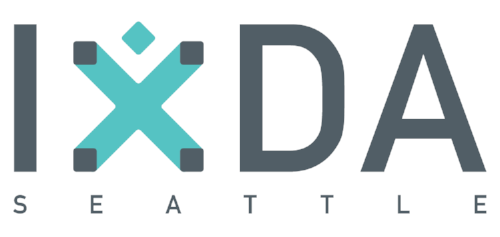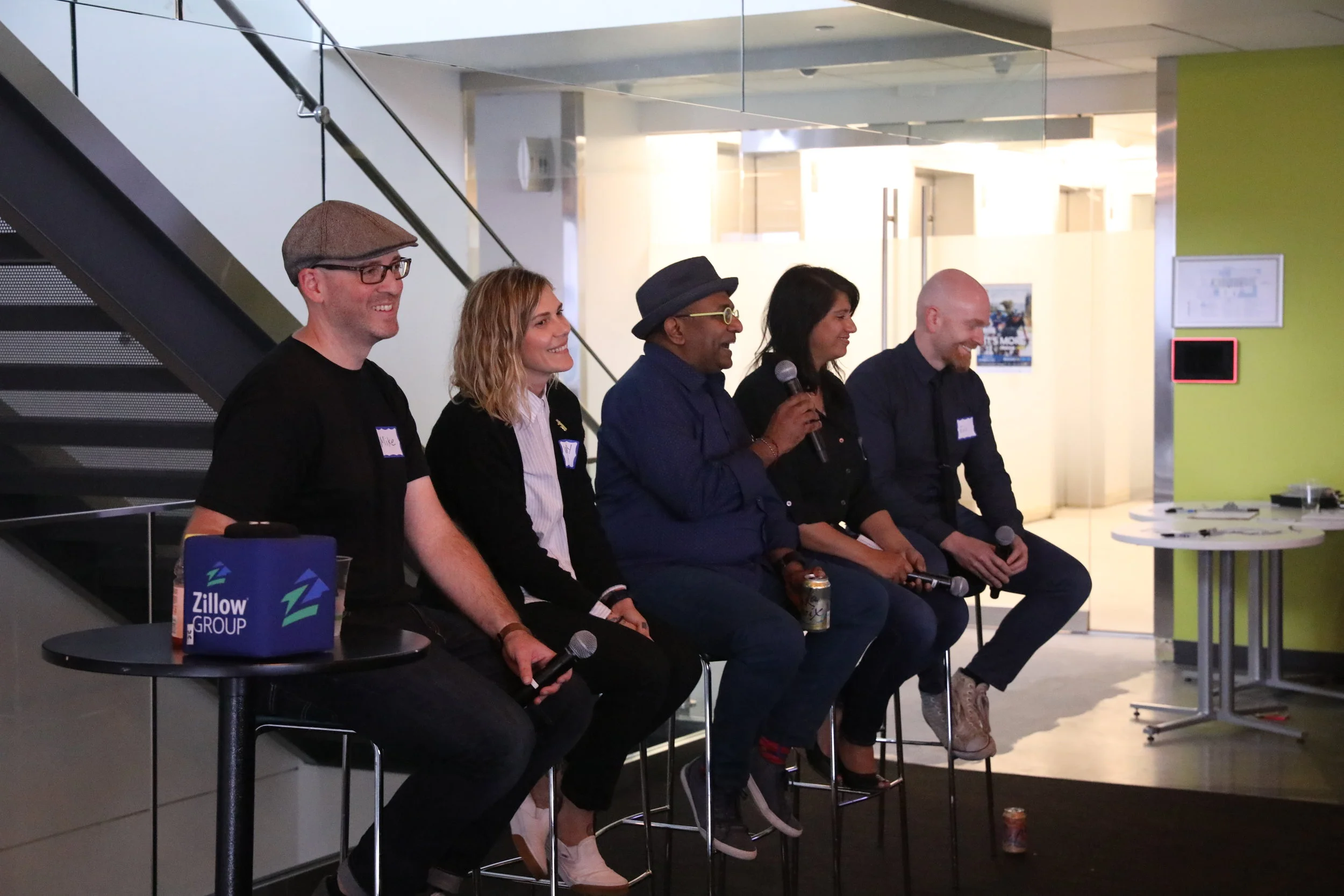Change Agents By Design
"We can make change wherever we’re at, with the tools that we have."
- Masuma Henry, Design Director at Amazon
Look outside, it’s going down
Can you, as a designer and researcher, apply your toolkit and experience to bigger and more complex design problems in your organization and society at large?
You don’t need to be told that there’s a lot going on in politics and activism right now. Of note, however, is the resurgence of internal company organizing and activism (see the work of groups like the Tech Workers Coalition). Designers in the Seattle area and elsewhere are being forced to examine how they show up in their companies and communities.
Let’s be real – It’s hard to only design apps when homelessness or other major inequalities are visible just outside the window of your office building.
Panelists speaking at Zillow on implementing design processes in changing culture.
At our June 27th event, “Metamorphosis: Using the Design Process to Empower Change,” Mike Knecht engaged panelists Masuma Henry, Whitney Thoren, Eric Tucker, and Surya Vanka in a conversation about designing for change. The panelists shared a wide-ranging discussion with the IxDA Seattle community about ways they are applying their design processes to affect their communities and beyond. The audience left inspired to apply the design process in a variety of ways beyond their immediate projects.
Based on this discussion, here’s a framework of the thinking and resources the evening’s panelists embrace, broken into the impact areas of Team, Organization, Society, and Planet for you to take action. This is not meant to be a comprehensive list - if you have thoughts or recommendations we’ve left out, we’d love to hear them!
Team
"Designers come with empathy."
- Eric Tucker, Design leader at Zillow
The team you work in can be the place you feel most comfortable creating change within, or the most difficult since it’s so close to home. Eric Tucker of Zillow discussed helping your team adopt an ‘experiment focused design mentality’ so that change could move forward in a low-risk way, a lean startup principle. For the launch of a tool allowing sellers to sell faster, Zillow’s design team launched a survey that helped provide evidence to the team that users value the trade off of losing money for the convenience of ease in selling.
Embracing Conflict
The Zillow team could only make this change by embracing the conflict inherent in challenging others on their team (including non-designers) to think beyond the bottom line by refocusing on users. This is important because any change a designer or anyone tries to make in an organization or society elicits disruption, which needs to be engaged in a mature manner.
Can such a process be scaled to affect social change? Surya Vanka thinks so – through his work with “DesignSwarms” he hopes to empower people to learn design processes in a joyful way, akin to games. Not everyone identifies as a designer but everyone can adopt aspects of the design mindset - DesignSwarms aims to achieve just this beyond just the design community.
Organization
“There are no separate systems. The world is a continuum. Where to draw a boundary around a system depends on the purpose of the discussion.”
― Donella H. Meadows, Thinking in Systems: A Primer
If you work for a large tech company, there are bound to be challenges - ones that may transcend the confines of just your company’s influence. A simple Google search of tech workplace activism will reveal a groundswell of movements happening at many of the largest tech companies that employ many in the UX community.
Our speaker Masuma Henry, a Design Director at Amazon, spoke about advocating for values of inclusion and diversity while working in tech companies as both an individual contributor and a manager. When people of color are the majority, or will soon be the majority, of a population, how do you make sure products and services are culturally competent in their communication, imagery, and overall service delivery for everyone? How does Amazon’s internal demographics affect the ability of Amazon to be both more inclusive and effective in its business? One way Amazon employees tackled the issue of inclusion was to program Alexa, which is already a female gendered voice, not answer known sexist questions. Masuma challenged us to think about what we are teaching children or anyone who might ask such questions of Alexa, and how these are intentional decisions that designers have to make in their product. She discussed with fellow panelists how inclusive design at the scale creates a 'curb cut effect,’ and how increasing inclusivity for all genders betters the experience for all populations using tools like Alexa.
She also owned that her organization, like any organization in the world, makes mistakes that can exclude certain groups. If you make a product mistake that excludes or harms certain groups, who is accountable and how do you rectify those mistakes? One resource shared by our audience was local agency Artefact’s Tarot Cards of Tech. Meant to help designers consider negative impacts of their designs, these cards can help provoke new thinking so that you build positive impacts with tech, not the next addictive social feed experience.
Society & Planet
"How do we move from the tech companies and into the real world?"
- Mike Kneckt, Design Manager at Zillow
The Seattle design community contributes in many ways to social change both within and outside the organizations they work for, but the entry points for opportunities (or making time for them) is not always clear. Whitney Thoren, who leads leadership development at Zillow, responded to Mike’s question with a call to bring design skills to nonprofits and social organizations to help them with their mission. Designers can do a lot to help those organizations institute the design process (or amplify their existing one), and increase their ability to be empathetic, agile, and experimental in achieving their mission. Locally outside of Zillow, Whitney actively works on helping bring nonprofit change agents and designers together through the AIGA Changemakers initiative, which provides many opportunities for designers to use their skills to promote nonprofit activities, campaigns, and programs.
There are also many other initiatives you can join to either improve the diversity of our design field at large or to use your design skills to help out our society.
Or, find a nonprofit or civic group and help! You can also do a tour of duty using your skills at the US Digital Service or 18F.
Conclusion
“Be experimental. Every day is the low-fi prototype for the next day.”
-Surya Vanka, founder of Authentic Design
There is no one way to be an effective change agent within your company or society at large. We hope this post serves as a provocation for discussion and action that you need to help align your purpose with your daily work and lifestyle. If you need further inspiration, join us at our next event featuring Brenda Laurel, a pioneer of interaction design on August, 9th at 6:30. Have more ideas around how to make a change? Continue the conversation with us on IxDA Seattle’s Twitter handle!

